Leadership is itself an engineering approach where resources need to be planned and executed to achieve the targets and when an engineering process needs leadership then the double game of engineering starts, several challenges come in the leadership of the software engineering process or software development process due to lack of technical background and lack of knowledge in technical advancement. The research aims to identify major challenges of the software development process and how these challenges can be managed using an AI-driven approach for the software development life cycle and explore the potential of AI-driven software development lifecycle optimization.
Hire senior developers vetted for technical and soft skills from a global talent network →
Leadership Challenges in the Software Development Lifecycle
The challenges in software development life cycle leadership are not only associated with responsibility distribution, scheduling, change management, scope management, and other project management parameters.
According to Gitnux statistics, 52.7% of software development projects fail to complete the project on budget. The statistics show that 78% of projects experienced failure due to scope creep. And 50% of projects were delivered late. The data shows that 52% of projects failed in the post-release test of the product.
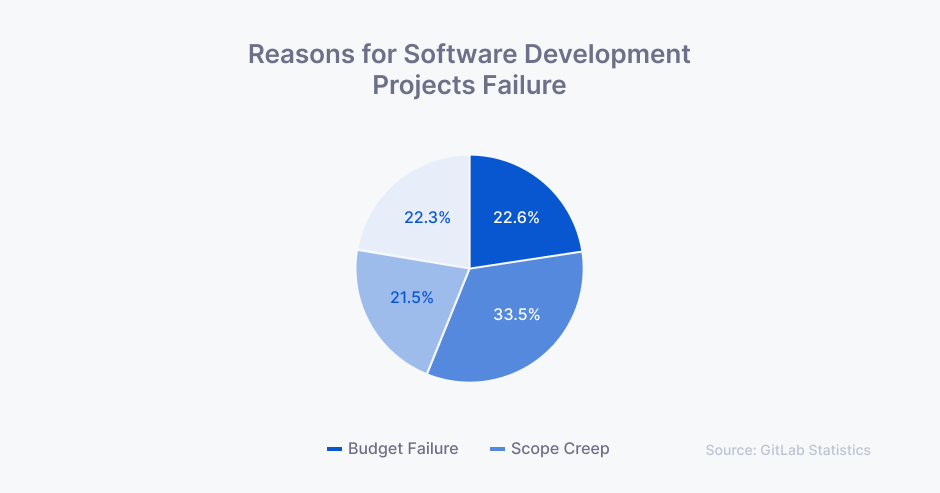
Software development projects often experience scope changes due to evolving requirements or stakeholder feedback. These changes can impact the distribution of responsibilities and require adjustments to tasks and timelines.
The other reason is limited resources, such as time, budget, and manpower, can affect the distribution of responsibilities in a software development project. Team members may be stretched thin, leading to burnout and decreased productivity. The guidelines or theories for leadership in the software development life cycle such as prioritizing tasks based on their importance to the project's success and considering outsourcing or hiring additional help if necessary have not been successful in controlling the waste or failures.
The core reason behind this is confusion and conflict within the team. After ensuring that each team member understands their role and responsibilities by clearly defining them in project documentation, such as the project charter or team charter no one can ensure project success because project depths and insights are unclear to the project leader.
Leaders' Struggle for Software Development Project Management
There are several areas that can cause difficulty in assessing the depth and ideas in frameworks of software development by leaders, three of which are elaborated here below.
Lack of Technical Background: Top management personnel who have not known anything about technology may have very hard time understanding the complex nature of software development. Lacking the experience and knowledge about programming languages, development models, and software architecture, they can remain at a disadvantage while offering guidance to members of their team.
Limited Exposure to Software Development: Those managers who barely dealt with software development processes may hardly envision the specificities and the tendencies which concern software products creation. If they have no first-hand exposure towards software development projects, they tend to rely on obsolete or incorrect assumption concerning the functioning of software development.
Failure to Keep Up with Technological Advancements: Individuals and companies engaged in software development have to face the constant influx of new technologies, tools and methodologies. Managers who do not have updated knowledge about these innovations may be unaware of the current trends and effective practices of creating software products, which may lead to the application of outdated strategies and lower efficiency.
AI-driven software development lifecycle optimization can be a valuable tool for leaders in the software development industry, helping to accelerate development speed, enhance strategic decision-making, optimize resource allocation, and improve software quality.
Steps Of AI-driven Software Development Lifecycle Optimization
The SDLC is a model that describes the procedure for the development and maintenance of a specific software through the various phases a software has to pass before it can be produced and marketed.
Planning & Requirements Gathering
The first phase therefore involve identification of goals and objectives for the user, work and functional description and user requirements . Here, considerations are made to ensure that the documentation prepared here is detailed in a manner that will make everyone who is involved in preparing it to understand it accordingly.
Design & Architecture
Specifications are prepared and developed, and these include technical and application specifications that draw a map of the software, system and its parts, data flow etc. Laying down such a plan helps in directing the development process.
Development & Implementation
Developers build, code and implement the design; and ensure that various functionality modules work in harmony with one another. This is where the actual software is coded in accordance with the specifications set by the planning and designing phases to achieve the software requirement specification.
Testing & Quality Assurance (QA)
Beta-testing, stress-testing, unit-testing, function-testing, and integration-testing are some of the testing procedures done in order to check for bugs, ensure correct functionality, and evaluate the performance of an application.
Deployment & Release
The specific software is then installed in the targeted host either down on the physical servers or in the cloud. This phase represent the launching phase of the total strategy.
Maintenance & Support
It is essential for the creators not to forget that the software doesn’t conclude after release. Maintenance involves such as correction of bugs or errors, addition of new features and release of security updates to make the use of the application more sleek.
In fact it is essential to grasp these SDLC phases since AIDD applies AI during various phases to improve performance and integration of repetitive tasks.
Role of Artificial Intelligence in Software Development
The use of Artificial Intelligence in software development is important step forward since many tasks are being automated and human abilities are amplified. Here's a breakdown of how AI plays a key role across various stages of the development process:
1. Requirements Gathering & Analysis
AI is capable of assessing user needs, data and feedback of past projects, and market trends on the needs of the user to come up with requirements. It is therefore possible to automatically generate initial feature lists and user stories by analyzing textual data derived from interviews, surveys and social media using Natural Language Processing (NLP) techniques.
2. Design & Architecture
AI can help in creating mockups and wireframes based on user personas and how they are likely to interact with the product. There is an ability to enhance the further versions of the software architectures based on certain algorithms of machine learning.
3. Development & Implementation
AI capability involves such tasks of coding where dull work such as producing template code, writing test cases, and providing code hints according to the environment can be ideal to be done by the machine. Here's a code snippet demonstrating code completion with a deep-learning model:
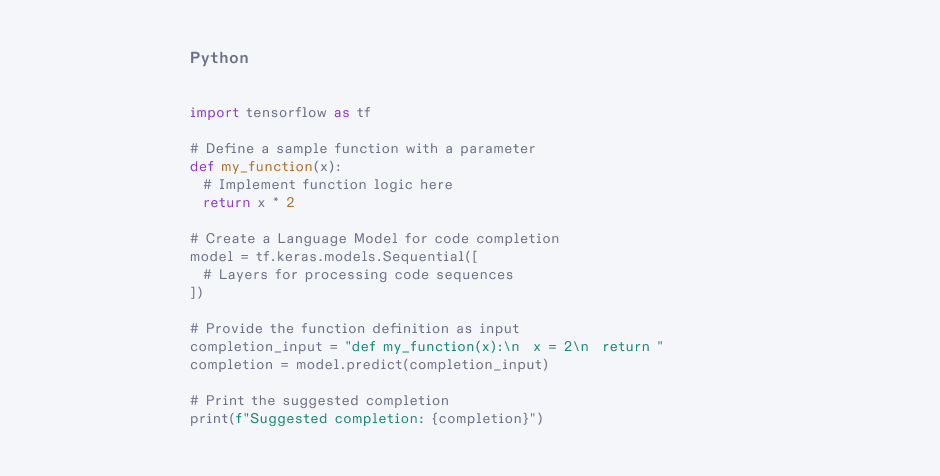
This is a simplified example, but it showcases how AI can predict the most likely code based on the context provided.
4. Testing & Quality Assurance (QA)
AI can be used to perform numerous forms of software testing such as unit testing, integration testing or even testing the user interface. In this way, using AI, tools are able to automatically create test cases according to coverage and detect defects better and more accurately.
5. Deployment & Release
AI also has applications for automating the software deployment process and for managing infrastructure, configuration, and rollbacks if something goes wrong.
6. Maintenance & Support
AI can analyze user behavior data and system logs to predict what problems may occur shortly and provide suggestions on preventive maintenance. AI chatbots can deal with straightforward customer inquiries, and offer some levels of self-service support to customers, in this way liberating the work of support staff.
In conclusion, AI becomes a helpful collaborator to developers who can shift to the more complex and creative work instead of spending the time on the repetitive and conventional tasks. It’s important to note, however, that while developers aren’t likely to be extinguished entirely by AI any time soon, there is little doubt that this technology will revolutionise software development in the future to some degree, contributing to shorter development cycles, improved quality, and streamlined methods.
Leveraging AI for Requirements Gathering and Analysis
Traditionally, requirements gathering relies on interviews, surveys, and workshops – all human-centric activities. While valuable, these methods can be time-consuming, prone to bias, and miss out on implicit user needs. AI offers a powerful alternative by automating and augmenting these processes. Here's how:
- Natural Language Processing (NLP): Using NLP, it is possible to process millions of words within various textual sources, such as user feedback, support tickets, social media comments, and documents of previous projects. Through keywords, phrases, and sentiment analysis, it is possible to determine the user’s pain points, preferences for features, and behaviors. It enables the analysis of how users require the system to work to achieve their goals in the best possible manner and can also reveal latent needs that stakeholders may not have stated.
- Text Summarization and Question Generation: AI can quickly aggregate user data and generate relevant summaries that help analysts to identify potential primary requirements. Furthermore, AI can provide the subsequent questions to get more specifics on certain observations or inquire more details about requirements.
- Clustering and Classification: A machine can group similar requirements together and this way the decision maker is able to come across patterns and potential problematic areas. This can be done using methodologies like k-means clustering; this is a set of methodologies that cluster data according to their likeness in a high dimensional space.
Technical Demonstration:
Here's a basic example using Python libraries for sentiment analysis of user reviews:
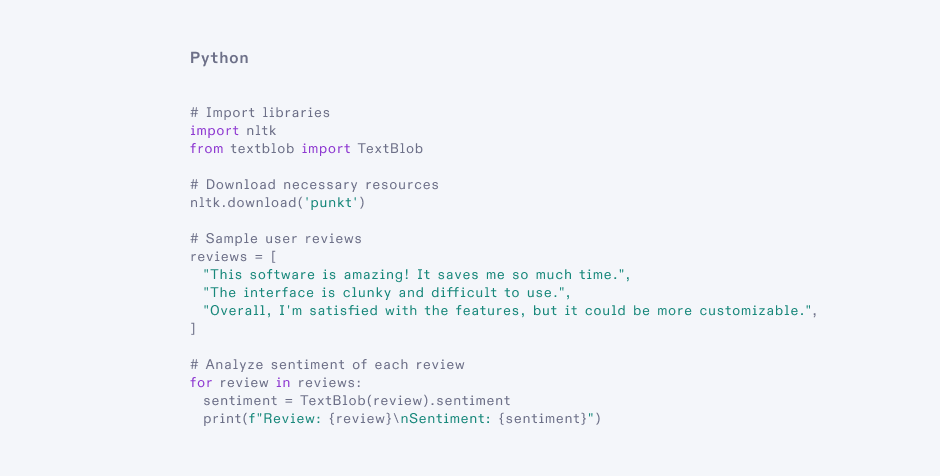
This code snippet utilizes TextBlob, a popular NLP library, to analyze the sentiment of user reviews. It categorizes the sentiment as positive, negative, or neutral, providing insights into user satisfaction and potential areas for improvement.
By using AI in requirements gathering, we can:
- Increase Efficiency: Automate time-consuming tasks, freeing up human analysts to focus on higher-level analysis and stakeholder engagement.
- Reduce Bias: Mitigate the influence of personal opinions and ensure requirements are based on objective data.
- Improve Completeness: Uncover hidden needs and ensure the final set of requirements accurately reflects user expectations.
While AI is a powerful tool, it's important to remember that it cannot replace human expertise. The ideal approach is a collaborative one, where AI assists with data analysis and pattern recognition, while human analysts retain the responsibility for critical thinking, interpretation, and validation of requirements.
AI-powered Design and Architecture Phase in SDLC
Design and architecture phase within the SDLC framework is one of the most imperative as it forms the basis of the subsequent developmental process. Conventional processes are more centralised and are often achieved by architects and designers using their knowledge to design solutions according to the gathered specifications. AI can significantly enhance this phase by:
- Generative Design Exploration: Combined with new technologies, AI can create a great number of design solutions based on some conditions set beforehand or requested by a client. This can embrace interfaces of gadgets, layout diagrams of a particular system or even designing a product. For this purpose, one can use techniques like GANs or any other suggestion that comes in handy when used in the core model.
- Predictive Modeling and Performance Analysis: The outcomes of the different choices of the design aspects can also be simulated by using machine learning algorithms on data collected from past events. This makes it possible for architects to have information that helps them in evaluating areas such as scalability, resource consumption and poor performant areas during the initial design phase of the project.
- Automated Code Generation: The basic idea here is that given the specific design and architecture which has been chosen AI tools are able to automatically provide code skeletons or entire modules. This can greatly minimize the time span required for development and enhance the quality of the code produced.
Technical Demonstration:
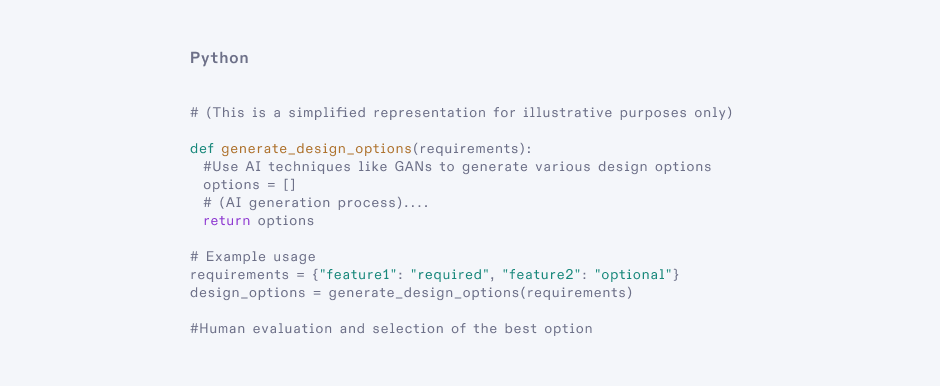
This illustrative code snippet showcases a function generate_design_options that takes user requirements as input and utilizes AI techniques to generate various design possibilities. In reality, the specific AI implementation would be significantly more complex.
By incorporating AI into design and architecture, we can:
- Enhance Creativity: Explore a wider range of design possibilities than what humans could brainstorm alone.
- Optimize Performance: Make data-driven decisions about architecture choices to ensure optimal performance and scalability.
- Accelerate Development: Automate repetitive tasks and code generation, freeing up developers to focus on complex logic and innovation.
It's important to remember that AI-powered design is still an evolving field. While AI can generate creative options and perform performance analysis, the final design decisions should always involve human expertise and domain knowledge.
Automated Code Generation and Refactoring Techniques with AI
The process of writing and maintaining clean, efficient code can be a significant bottleneck in software development. AI offers exciting possibilities for automating these tasks, leading to faster development cycles and improved code quality. Here's a deeper look at how AI is revolutionizing code generation and refactoring:
- AI-powered Code Generation:
- Template-based Generation: AI can analyze existing codebases and user-defined templates to automatically generate code snippets or boilerplate code for common functionalities. This can significantly reduce development time for repetitive tasks.
- Natural Language Processing (NLP): Advanced NLP techniques allow developers to describe desired functionalities in natural language. The AI then translates this natural language description into actual code, streamlining the development process.
- AI-assisted Refactoring:
- Code Smell Detection: AI models can be trained to identify code smells – indicators of poorly written code – such as duplicate code, long methods, or complex control flow. This helps developers prioritize refactoring efforts towards areas that will yield the most significant improvements.
- Automated Refactoring Suggestions: Once code smells are identified, AI can suggest appropriate refactoring techniques and even automatically apply safe refactoring operations. This can significantly improve code maintainability and readability.
Technical Demonstration:
Here's a code snippet (using Python) demonstrating basic template-based code generation:

This snippet showcases a simplified auto_complete function that leverages a pre-trained AI model to predict the most likely code continuation based on the provided prefix. While this is a basic example, more sophisticated AI models can handle complex contexts and suggest entire code blocks or functions.
AI in code generation and refactoring offers several benefits:
- Increased Productivity: Developers can write code faster by leveraging auto-completion and reducing the need for manual refactoring.
- Improved Code Quality: AI can identify and suggest fixes for potential code issues, leading to more robust and maintainable codebases.
- Reduced Errors: Automating repetitive tasks can minimize human errors introduced during manual coding.
It's important to acknowledge limitations. AI-generated code might require human review and adjustments to ensure it aligns perfectly with project requirements and coding standards. Additionally, complex refactoring scenarios might still necessitate human intervention.
Hire senior AI developers vetted for technical and soft skills from a global talent network →
AI-based Testing and Quality Assurance Processes
Quality Assurance (QA) is paramount for ensuring software applications function as intended. AI is transforming the QA landscape by automating tasks, improving test coverage, and enhancing defect detection. Here's a glimpse into how AI tackles testing:
- Automated Test Case Generation: AI can analyze application logic, user behavior patterns, and historical defect data to automatically generate comprehensive test cases. This includes tests for edge cases and scenarios that might be overlooked during manual test design.
- Test Data Optimization: AI algorithms can create realistic test data that mimics real-world usage patterns. This reduces the need for manual test data creation and improves the effectiveness of testing.
- AI-powered Test Execution and Analysis: AI can automate repetitive test execution tasks, freeing up testers to focus on more strategic activities. Additionally, AI can analyze test results to identify patterns, predict potential defects, and prioritize bug fixes.
- Visual Testing with Image Recognition: For graphical user interfaces (GUIs), AI can leverage image recognition to detect visual inconsistencies, layout issues, and UI element malfunctions. This helps ensure a consistent and visually appealing user experience.
Technical Demonstration:
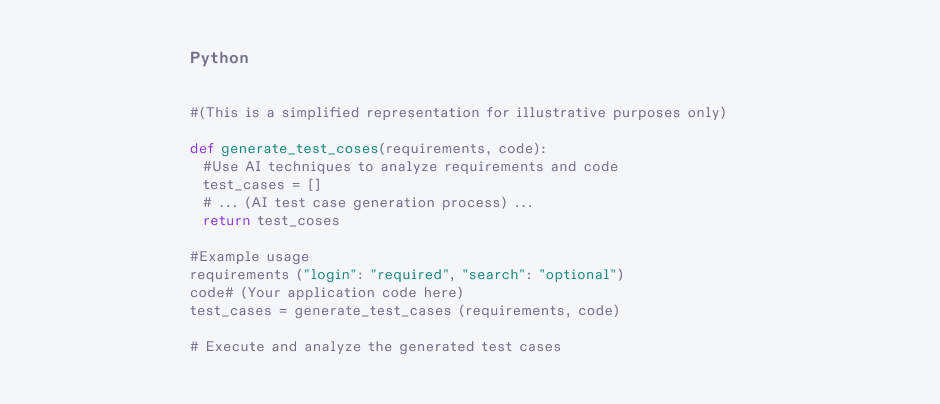
This code snippet illustrates a function generate_test_cases that takes requirements and code as input and utilizes AI techniques to generate a set of test cases. The actual implementation would involve specific AI algorithms and frameworks.
Benefits of AI-based Testing:
- Improved Test Coverage: AI can automate the creation of a wider range of test cases, leading to more thorough testing and reduced chances of bugs slipping through the cracks.
- Enhanced Efficiency: Automating repetitive tasks like test execution frees up testers for higher-level activities like test strategy and exploratory testing.
- Early Defect Detection: AI can analyze test results and identify potential issues early in the development lifecycle, allowing for faster bug fixes and reduced development costs.
While AI offers significant advantages, it's crucial to remember that it's not a silver bullet. Testers still play a vital role in designing overall test strategies, interpreting AI-generated results, and performing exploratory testing that goes beyond the automation capabilities of AI.
Continuous Integration and Deployment (CI/CD) with AI
Traditionally, CI/CD pipelines rely on pre-defined scripts and tests to automate the build, test, and deployment process. AI can significantly enhance CI/CD by:
- Intelligent Test Selection: Automated testing tools can automatically assess the modifications made to the code as well as the previous test results and come up with the list of the most relevant test cases for each build. This saves time available to conduct a particular test and also helps to manage available resources efficiently.
- Predictive Performance Analysis: One of the approaches that can be used to estimate the possibility of negative affections on AP is the machine learning models used to train it to predict the impact of codes’ changes. This helps developers to be able to pinpoint areas that would be slow in their operations and take necessary measures before the end product is deployed.
- Self-healing Infrastructure: It can be focused on checking the CI/CD pipeline and infrastructure for irregularities and possible issues. Occasionally, it can also take measures such as automatically relaunching failed jobs or adjusting the deployment of resources as needed.
- AI-powered Rollback Strategies: It can use data from previous deployments and feedback gathered from the users to estimate the repercussion that the new version may have. This makes it possible to apply intelligent critique in case of some random problems arriving after deployment.
Technical Demonstration:
Code Snippet (Illustrative - Not for direct implementation).
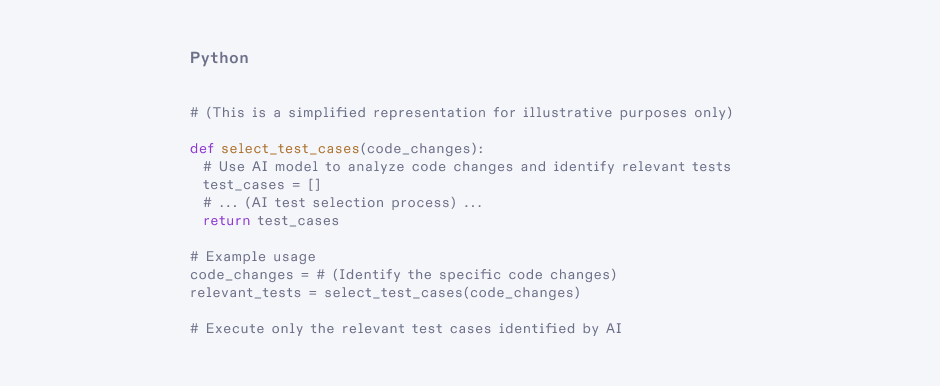
This code snippet showcases a simplified function select_test_cases that leverages an AI model to analyze code changes and choose the most relevant test cases to be executed within the CI/CD pipeline. The actual implementation would involve specific AI models and frameworks trained on historical data.
Benefits of AI-powered CI/CD:
- Faster Release Cycles: Intelligent test selection and performance analysis enable faster and more efficient deployments.
- Improved Software Quality: AI-powered testing and performance predictions help identify and address potential issues before they reach production.
- Enhanced Reliability: Self-healing infrastructure and intelligent rollback strategies ensure the CI/CD pipeline and deployments are more robust and resilient to failures.
While AI brings significant advancements, it's important to acknowledge that CI/CD pipelines still require human oversight and configuration. AI models need to be carefully trained and monitored to ensure they are selecting appropriate tests and making accurate predictions.
Read more: Introduction to Software Development Lifecycle
Predictive Maintenance and Bug Detection Using Machine Learning
Machine learning (ML) plays a crucial role in both predictive maintenance and bug detection. Here's a breakdown of how ML tackles these challenges:
Predictive Maintenance:
- Data Acquisition and Preprocessing: Sensors embedded in equipment continuously collect data on various parameters like temperature, vibration, and power consumption. This data is preprocessed to clean and format it for machine learning algorithms.
- Anomaly Detection: Unsupervised learning techniques, like k-nearest Neighbors (KNN) or Isolation Forests, can identify deviations from normal operating patterns. This indicates potential equipment degradation and allows for preventive maintenance before breakdowns occur.
- Regression Techniques: Supervised learning algorithms, like Support Vector Machines (SVM) or Random Forests, can be trained on historical data to predict the Remaining Useful Life (RUL) of equipment. This allows for scheduling maintenance interventions at optimal times.
Bug Detection:
- Supervised Learning for Classification: Historical data containing bug reports and code characteristics can be used to train supervised learning models. These models, like Logistic Regression or Decision Trees, learn to classify code snippets as bug-free or bug-prone based on various features.
- Natural Language Processing (NLP): NLP techniques can analyze bug reports and user feedback to identify patterns and recurring issues. This can help developers prioritize bug fixes and identify areas where the code might be particularly error-prone.
- Clustering for Root Cause Analysis: Unsupervised learning techniques like k-means clustering can group similar bug reports together. This can help identify underlying root causes and prevent similar bugs from recurring in the future.
Technical Demonstration:

This code snippet showcases a simplified example using KNN for anomaly detection in sensor data. The model is trained on historical data labeled as normal or anomaly. New sensor data is then fed into the model to predict if it signifies an anomaly, potentially indicating equipment degradation.
Similarly, machine learning techniques can be applied to code analysis and bug detection. By leveraging machine learning for predictive maintenance and bug detection, we can:
- Reduce Downtime: Proactive maintenance prevents unexpected equipment failures and reduces downtime and production disruptions.
- Improve Software Quality: Early bug detection leads to faster bug fixes and more stable software releases.
- Optimize Resource Allocation: Maintenance and bug-fixing efforts can be targeted toward areas with the highest likelihood of issues.
It's important to remember that the effectiveness of machine learning models relies heavily on the quality and quantity of training data. Furthermore, these models require ongoing monitoring and retraining to maintain accuracy as conditions or codebases evolve.
Read more: How to Hire Machine Learning Engineers
Utilizing Natural Language Processing (NLP) for Documentation and Communication
Traditional software development heavily relies on written documentation, leading to challenges like information overload and difficulty in finding relevant information. NLP can revolutionize how we create, manage, and interact with documentation, fostering more efficient communication and knowledge sharing within development teams. Here's how:
- Automated Documentation Generation: NLP can analyze code comments, commit messages, and existing documentation to automatically generate comprehensive API references, user guides, and system architecture overviews. This reduces the manual effort required for documentation creation and ensures consistency across different parts of the codebase.
- Information Retrieval and Summarization: NLP techniques can be used to search and retrieve relevant documentation snippets based on user queries. Additionally, NLP can automatically summarize complex documents, providing developers with concise overviews of key concepts and functionalities.
- Conversational AI for Knowledge Sharing: Chatbots powered by NLP can answer developer questions about the codebase, system architecture, or best practices. This allows developers to access information quickly and efficiently without sifting through extensive documentation.
Traditional project management often relies on manual processes for planning, assigning tasks, and managing resources. AI injects intelligence into these tasks, leading to significant improvements in efficiency and success rates. Here's a breakdown of how AI tackles these challenges:
Enhanced Project Planning:
- Machine Learning for Task Duration Estimation:
- Historical project data is used to train algorithms like Support Vector Regression (SVR) or Random Forests.
- These algorithms learn to predict the duration of similar tasks based on factors like complexity, size, and required skill sets.
- Dependency Analysis:
- Techniques from graph theory are used to identify dependencies between tasks.
- This ensures a clear understanding of the order in which tasks can be completed.
Optimized Resource Allocation:
- Matching Skills and Workload: AI can analyze team member profiles, including skills, experience, and current workload.
- Constraint Satisfaction Algorithms: Techniques like linear programming or constraint satisfaction algorithms are used to find optimal task assignments that consider:
- Skills: Matching task requirements with team member skillsets.
- Workload: Ensuring team members are not overloaded and can efficiently manage assigned tasks.
- Availability: Taking into account team members vacation schedules or existing commitments.
Enhancing DevOps Practices with AI
Traditional DevOps workflows often rely on manual effort for tasks like code testing, infrastructure provisioning, and configuration management. AI injects automation and intelligence into these processes, leading to:
- Automated Testing: AI-powered tools can analyze code, identify potential vulnerabilities, and generate comprehensive test cases. Techniques like deep learning models can be used for image recognition in UI testing, while natural language processing (NLP) can be leveraged for code review and comment analysis to identify potential issues.
- Infrastructure Optimization: AI can analyze historical data on resource usage to predict future needs and scale infrastructure automatically. Techniques like time series forecasting and anomaly detection can be used for this purpose.
- Self-Healing Infrastructure: AI can detect and diagnose infrastructure issues proactively, enabling self-healing mechanisms to resolve problems automatically. Techniques like anomaly detection and unsupervised learning can be used to identify deviations from normal behavior and trigger corrective actions.
Technical Demonstration:
Code Snippet (Illustrative - Not for Real-World Implementation).
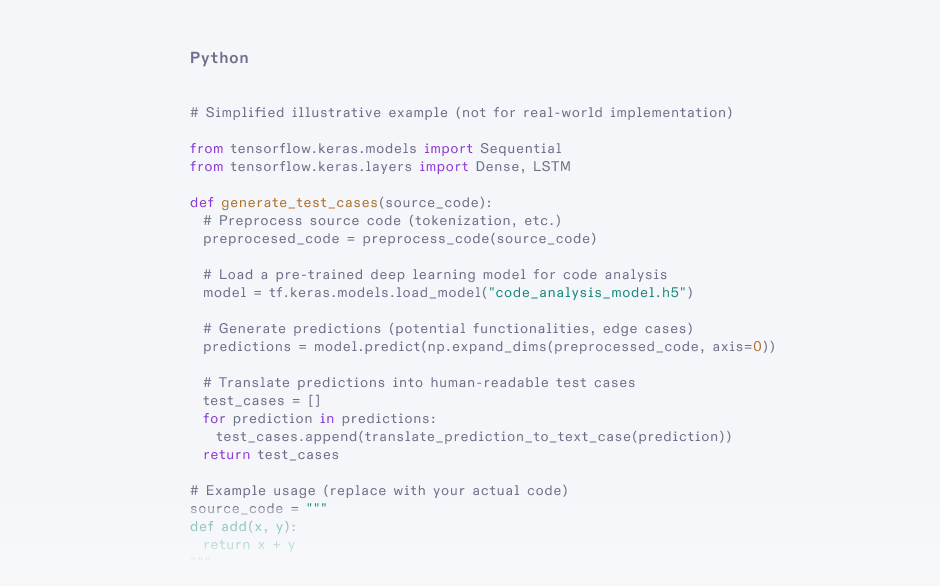
Data-driven Decision Making in Software Development
Software development traditionally relied on intuition and experience for decision-making. However, the abundance of data generated throughout the Software Development Lifecycle (SDLC) presents a valuable opportunity to leverage data analytics and AI for more informed choices. Here's a breakdown of how AI facilitates data-driven decision making in software development:
- Performance Monitoring and Analysis:
- Data Collection: AI-powered tools can automatically collect and aggregate data from various sources throughout the SDLC, including:
- Application performance metrics (CPU/memory utilization, response times, error rates)
- Code quality metrics (code coverage, static analysis results)
- User behavior data (clicks, interactions, feature usage)
- Data Visualization and Alerting: This data is then visualized in dashboards and reports, providing developers with insights into software performance, resource usage, and user behavior. Techniques like anomaly detection can be used to identify deviations from normal behavior and trigger alerts for potential issues.
- Data Collection: AI-powered tools can automatically collect and aggregate data from various sources throughout the SDLC, including:
- Predictive Analytics:
- Training AI Models: Historical data is used to train machine learning models to predict future trends, such as:
- Defect Prediction: Models can identify code areas with a higher likelihood of introducing bugs, allowing for targeted code reviews and testing efforts. Techniques like logistic regression or random forests can be used for defect prediction.
- User Churn Prediction: By analyzing user behavior patterns, models can identify users at risk of abandoning the software. This enables proactive efforts to improve user retention. Techniques like survival analysis can be used for churn prediction.
- Resource Requirement Prediction: Models can predict future resource needs based on historical data and project scope. This helps in optimal resource allocation and avoids bottlenecks. Techniques like time series forecasting can be used for resource requirement prediction.
- Training AI Models: Historical data is used to train machine learning models to predict future trends, such as:
Technical Demonstration:
Code Snippet (Illustrative - Not for real-world implementation).
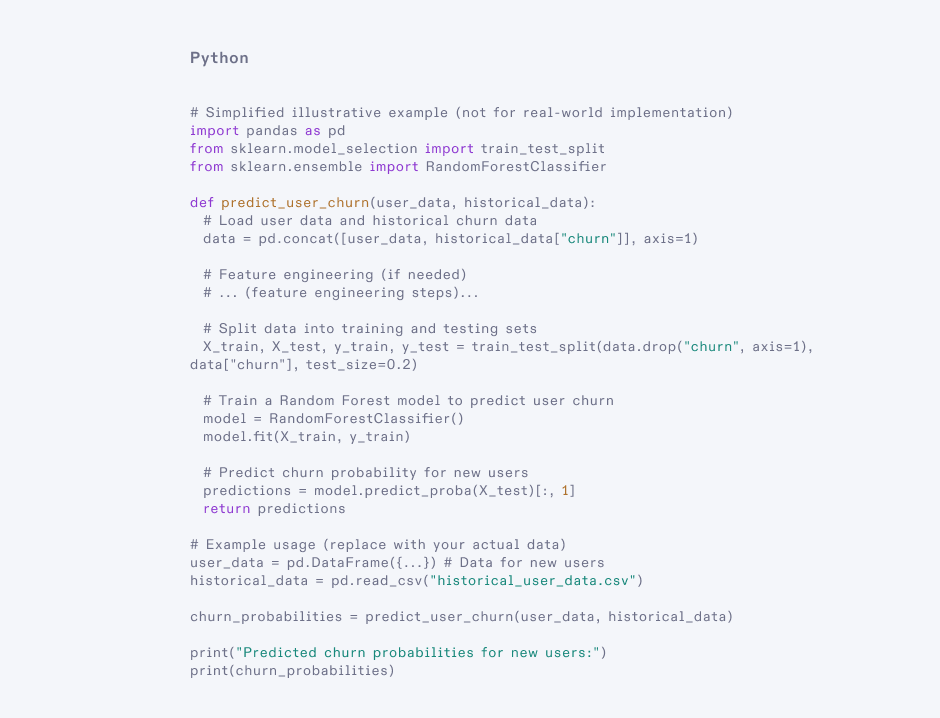
Benefits of Data-Driven Decision Making:
- Improved Software Quality: Early defect prediction allows for proactive bug fixing, leading to higher quality software.
- Enhanced User Experience: Identifying user behavior patterns helps in prioritizing features and optimizing functionalities for better user engagement.
- Optimized Resource Allocation: Resource requirements can be predicted, enabling efficient resource allocation and avoiding bottlenecks.
Ethical Considerations and Challenges in AI-driven SDLC Optimization
While AI offers significant advantages for optimizing the SDLC, ethical considerations and challenges need careful attention:
- Bias in Data: AI models trained on biased data can perpetuate those biases in their outputs. This could lead to unfair resource allocation, biased code review recommendations, or discriminatory user experiences. It's crucial to ensure training data is diverse and representative to mitigate bias. Techniques like data debiasing and fairness metrics can be employed.
- Explainability and Transparency: AI models, particularly deep learning models, can sometimes be opaque in their decision-making processes. This lack of transparency can make it difficult to understand how and why the model arrived at a particular recommendation. Explainable AI (XAI) techniques can help to shed light on the model's reasoning, fostering trust and enabling human oversight.
- Job displacement: Automation through AI could potentially lead to job displacement in the software development field. However, it's more likely to shift the focus towards human-AI collaboration, where AI handles repetitive tasks and humans leverage their creativity and critical thinking for higher-level decision-making.
- Security and Privacy: Integration of AI introduces new security and privacy concerns. Data used to train AI models might contain sensitive information, requiring robust security measures and anonymization techniques. Additionally, AI models themselves could be vulnerable to adversarial attacks that manipulate their outputs. Secure data handling practices and robust model development are crucial to mitigate these risks.
- Algorithmic Accountability: As AI plays a more prominent role in software development, establishing accountability for its decisions becomes essential. Defining clear ownership and responsibility for the outcomes of AI-driven processes is vital.
Real-World Implementations of AI in SDLC Optimization
AI is transforming the SDLC by automating tasks, improving decision-making, and accelerating development processes. Here are some real-world examples:
- Automated Code Review and Testing: AI-powered tools can analyze code for potential bugs, security vulnerabilities, and adherence to coding standards. This frees up developer time for more complex tasks. Techniques like deep learning models can be used for code analysis, while natural language processing (NLP) can be leveraged for code review comment analysis.
- Intelligent Test Case Generation: AI can analyze user stories, functional requirements, and code structure to automatically generate comprehensive test cases. This helps ensure thorough testing coverage and reduces manual effort. Techniques like natural language processing and graph theory can be used for this purpose.
- Performance Optimization and Resource Allocation: AI can analyze historical performance data to identify bottlenecks and predict future resource needs. This allows for proactive optimization of infrastructure usage and resource allocation for development teams. Techniques like time series forecasting and anomaly detection can be valuable for these purposes.
- Chatbots for Customer Support and Feedback Analysis: AI-powered chatbots can provide 24/7 customer support, answer basic questions, and collect user feedback. Natural language processing allows chatbots to understand user queries and provide relevant responses. Additionally, AI can analyze customer feedback data to identify recurring issues and areas for improvement.
- Predictive Maintenance for Development Environments: AI can monitor development infrastructure and predict potential issues before they occur. This helps to prevent downtime and ensure continuous development workflows. Techniques like anomaly detection and time series forecasting can be used for predictive maintenance.
Here are some examples:
Adobe Sensei (Adobe XD): Adobe Sensei is Adobe's AI and machine learning platform that powers features in Adobe XD, their UI/UX design tool. It offers features like Auto-Animate, Content-Aware Layout, and Responsive Resize to help designers create responsive and interactive designs more efficiently.
Figma with FigPi: Figma is a collaborative interface design tool that now integrates with FigPig, an AI plugin. FigPig uses machine learning to analyze design layouts and automatically suggest improvements, such as alignment adjustments and spacing corrections, helping designers create more visually consistent designs.
Sketch with Sketchbox: Sketch is a popular design tool among UI/UX designers, and Sketchbox is an AI-powered plugin that enhances its capabilities. Sketchbox offers features like auto layout, responsive design suggestions, and dynamic components to help designers create adaptive and user-friendly interfaces.
UXPin with Merge: UXPin is a design platform that recently introduced Merge, an AI-powered design system that integrates with UXPin's design tools. Merge analyzes design components and suggests patterns, styles, and interactions to help designers maintain consistency and improve usability across their designs.
Adobe Color CC: Adobe Color CC is an AI-powered tool that helps designers create color schemes and palettes based on color theory principles and user preferences. It can generate harmonious color combinations, suggest complementary colors, and analyze images to extract color themes.
These AI-based UI and UX tools complement traditional design workflows by automating repetitive tasks, providing intelligent suggestions, and helping designers make informed decisions throughout the design process.
Coding and Implementation
AI-powered tools can aid developers by providing code suggestions, automating repetitive tasks through code generation, and even detecting potential bugs or security vulnerabilities through static code analysis. Here are some notable AI-powered tools for coding and implementation:
- TabNine: Uses machine learning models to provide context-aware code completions and suggestions as you type, improving coding speed and accuracy.
- Kite: Offers AI-powered code completions and snippets based on your coding context, helping you write code faster and with fewer errors.
- DeepCode: Applies machine learning techniques to analyze your code and provide suggestions for improving code quality, identifying bugs, and preventing security vulnerabilities. These AI-powered tools for coding and implementation can help developers write cleaner, more efficient code, identify and fix bugs faster, and streamline the software development process. However, it's essential to use these tools judiciously and complement them with human expertise to ensure the best outcomes.
AI optimized Testing Phase
AI can improve testing efficiency by automatically generating test cases, predicting areas of code most prone to defects, and prioritizing tests based on risk analysis. AI-driven test automation tools can also help in executing tests more rapidly and accurately. For example:
Diffblue Cover: Uses AI to automatically generate unit tests for Java code, helping developers identify and fix bugs early in the development process.
Mabl: Employs machine learning algorithms to automatically create and maintain end-to-end test cases for web applications, reducing the time and effort required for manual testing.
AI-based Deployment and Maintenance: AI can optimize deployment processes by predicting resource requirements, identifying potential deployment issues, and automating deployment pipelines. Furthermore, AI-based monitoring systems can continuously analyze system performance, detect anomalies, and even predict potential failures before they occur.
AI-based leadership in SDLC: AI can assist project managers in resource allocation, scheduling, and risk management by analyzing project data, team performance, and external factors influencing project success. AI-powered Platforms such as Asana, Trello, and Jira utilize AI algorithms to automate task prioritization, schedule optimization, and resource allocation based on project goals and team capacity.
The Bottom Line
By integrating AI technologies into each phase of the SDLC, organizations can achieve significant improvements in productivity, quality, and time-to-market. However, it's essential to ensure that AI-driven solutions are ethically developed and deployed, considering factors such as bias, privacy, and security. Additionally, human expertise remains crucial in guiding and validating AI-driven decisions throughout the SDLC. By embracing AI-driven Software Development Lifecycle Optimization, organizations can stay competitive in today's rapidly evolving digital landscape, delivering superior software products that meet the evolving needs of users and stakeholders. For those looking to lead in Engineering Leadership, Hiring, or Product Leadership roles, the path to success lies in using AI strategically and ethically to drive innovation and excellence in software development.
Read More: 15 Less-Known Benefits of Hiring Contractors Over In-House Employees
Let Index.dev be your trusted partner in hiring qualified and vetted developers or building a robust high-performing LLM team with confidence.
And if you're a skilled LLM developer seeking high-paying remote jobs, joining Index.dev can connect you with promising projects in the US, UK, and EU markets.